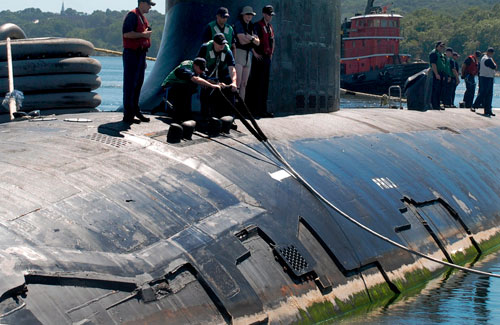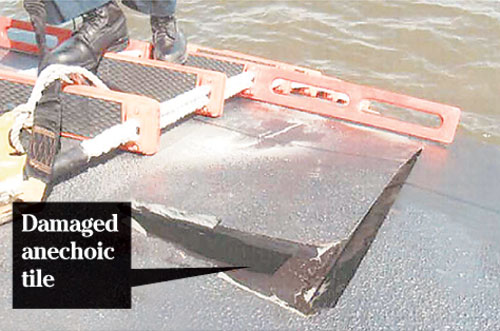Coating falling off Virginia-class subs

The Navy acknowledges that there have been problems with the special coating that helps to make Virginia-class nuclear-powered attack submarines stealthy. Here, the attack submarine USS Virginia leaves the Naval Submarine Base New London in Groton, Conn.

Close-up of acoustic coating debonding that has occurred on Virginia-class submarines.


A rubberlike coating applied to dampen sound on the Navy’s Virginia-class attack submarines has been sloughing off in large sections at sea, a problem experts say could reduce the sub’s stealth and likely will cost millions of dollars to repair.
The USS Texas returned to Pearl Harbor on Aug. 23 from a three-month deployment to the eastern Pacific with its acoustic urethane coating in tatters.
Missing chunks of the coating, formally called the "Mold-In-Place Special Hull Treatment," also have been observed or reported on the USS Hawaii, based here; the North Carolina, which is on its way to Pearl Harbor as a new home port; and on the Virginia, based on the East Coast.
The issues are part of a series of problems to come to light on the Virginia-class submarines, which were designed as a more economical replacement for the Seawolf subs, which cost $4.4 billion each. The Virginia-class subs cost more than $2 billion.
Reliability problems with the Virginia-class subs and other weapons systems were described in a June 30 memo by J. Michael Gilmore, the Pentagon’s director of operational test and evaluation. The memo noted a November 2009 review that found multiple "fail to sail" issues and test aborts related to low reliability.
Gilmore cited "multiple subsystem failures" with the towed sonar array, photonics mast, radar and vertical launch system tubes. He also pointed out that the hull coating continued to peel off while subs were underway, often in large sections of up to hundreds of square feet.
Don't miss out on what's happening!
Stay in touch with breaking news, as it happens, conveniently in your email inbox. It's FREE!
The Naval Sea Systems Command, based in Washington, D.C., is downplaying the problem.
TILES REDUCE ECHO » Anechoic, or echo-reducing, tiles were used by Germany on submarines in World War II. |
"Despite reports to the contrary, hull coating debonding is not a severe problem and has not measurably affected the performance of the ships," the command said in an e-mailed response to the Star-Advertiser.
The command said the "fail to sail" critique by Gilmore did not relate to debondings.
While the new hull coating is intended to be "efficient and cost-effective," some bugs are still being worked out, the Navy said.
"While largely successful, the process is just finishing the fine-tuning to resolve problems experienced in the first few ships."
The Navy did not specify the cause of the problems.
The USS Virginia, which has experienced the most debonding to date, nevertheless was given the "highest possible score" in operational tests, the sea systems command said. The Virginia also recently completed a full-length operational deployment during which the ship had the highest operational tempo of any deployed attack submarine, the command said.
However, naval analyst and author Norman Polmar, who served as a consultant to three secretaries of the Navy, said the large-scale coating loss on Virginia-class subs and the irregular surfaces created by it can be a significant problem.
"They lose their stealthiness to passive sonar because they are making noise when they move, and to active sonar because there’s exposed steel," he said. Passive sonar involves listening for sounds like propellers; active sonar involves sending a "ping" through the water and listening for echoes.
Polmar also said the debonding will cost millions of dollars to repair.
"I would say it’s a significant problem, but certainly it’s not a game killer," he said. "We’re not going to stop producing them because of this. We’re not going to tie them all up because of this."
The Navy said repairs can be done at Pearl Harbor Naval Shipyard, but the cost to replace the coating depends on the amount missing and its location on the ship. No cost estimate was given. Officials said that in general, the repairs can be made in a few days.
The Navy said the debonding was first noticed in 2007 on the Virginia, the first in the class.
"Both material and application issues are being corrected," the Sea Systems Command said.
Anechoic, or echo-reducing, tiles were used by Germany on submarines in World War II. The application helps break up incoming sound waves, and reduces outgoing noise. The Soviets also adopted the use of the tiles, and the U.S. followed suit in 1988.
The 377-foot Virginia subs, displacing 7,800 tons, are touted as being as quiet as the Seawolf, of which only three were built, and much quieter than Los Angeles-class submarines. In addition to its three Virginia-class submarines — a number that will grow — Pearl Harbor is home to 15 older Los Angeles-class subs.
Northrop Grumman Newport News is teamed with General Dynamics Electric Boat to build the first 10 ships of the Virginia class. Navy plans call for 30 Virginia-class subs in the fleet.




